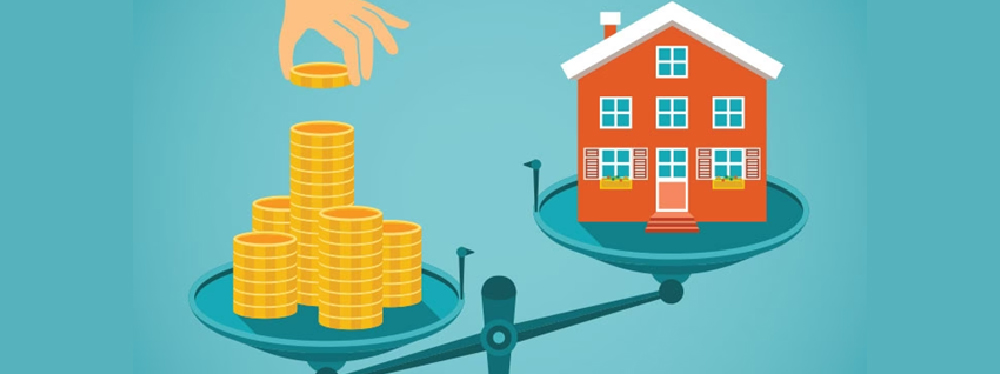In real estate, financial metrics are key to making informed decisions. These metrics help buyers, investors, and developers assess their investments and obtain the best financing terms. One of the most important tools in this financial toolbox is the Loan-to-Value (LTV) ratio.
The LTV ratio is a key indicator that tells you what percentage of the property value can be financed through a loan. For luxury home buyers, property developers, or investors entering high-value markets, the LTV ratio is even more important as it helps manage risk and plan.
Whether you are new to real estate or an experienced investor, understanding the LTV ratio is important for hassle-free and strategic property investment.
What is the Loan-to-Value (LTV) Ratio?
Loan-to-Value (LTV) ratio is a widely used financial metric in real estate that measures the loan amount to the property value. This ratio is important for both lenders and borrowers as it reflects the risk involved in a mortgage or property loan.
LTV ratio is calculated as follows:
LTV Ratio = (Loan Amount ÷ Appraised Property Value) × 100
This formula gives you the percentage of the property’s value that is financed through the loan.
Why LTV Matters in Real Estate Deals
- Lender’s Risk Mitigation: Lower LTV means lower risk for the lender and better loan terms for the borrower.
- Financing Eligibility: Many lenders have LTV limits to determine the maximum loan amount they can give.
- Financial Planning for Buyers: Understanding the LTV ratio helps borrowers decide their down payment size and anticipate long-term repayment obligations.
Read Also: Home Loan vs Land Loan – All You Need to Know

How LTV Ratio Works in Real Estate
The LTV ratio is the foundation of property finance. It determines loan approvals, terms, and interest rates. For buyers and lenders, this is the key to understanding real estate transactions.
LTV’s Role in Mortgage and Loan Eligibility
- Buyers with lower LTVs are seen as less risky by lenders and get smoother approvals and fewer conditions.
- Higher LTVs, while still possible in some cases, may require buyers to pay for mortgage insurance or accept higher interest rates.
How Lenders Use LTV for Risk Assessment
- Repayment Probability: Lenders use LTV to determine how likely the borrower is to repay the loan. A higher LTV means a higher risk of default.
- Terms and Conditions: The ratio determines the flexibility and affordability of the loan terms offered by the lender.
Interest Rates and Loan Terms
- Buyers with lower LTVs get lower interest rates which means a lower cost of borrowing.
- Higher LTVs may mean stricter repayment schedules and higher premiums to compensate for the lenders’ risk.
Factors that Affect LTV Ratio in Real Estate
Several factors affect the LTV ratio in real estate transactions. Knowing these factors will help buyers and investors prepare and plan accordingly.
1. Property Type
- Luxury Properties: Due to higher values, luxury properties require bigger down payments, which affects the LTV.
- Commercial Properties: Lenders have stricter LTVs for commercial properties, given the business risk involved.
- Residential Properties: These have more relaxed LTV terms compared to luxury or commercial properties.
2. Borrower’s Financials
- Credit Score: A good credit score can compensate for higher LTV by showing lenders the borrower is reliable.
- Debt-to-Income (DTI) Ratio: Although separate from LTV, the DTI ratio is another parameter that lenders consider along with LTV.
3. Market Conditions
- Economic Trends: A good market can reduce LTV over time as property values increase.
- Local Market Trends: Falling property values in a particular area can increase LTV for existing loans and refinance.
Read also: Commercial Property vs Residential Property: Which is a Better Investment?
Benefits for Real Estate Buyers
The LTV ratio is very useful for property buyers, especially those who are buying high-end or luxury properties when planning, negotiating, and managing their investments.
1. Better Planning
- Buyers can use the LTV ratio to estimate how much equity they need upfront and plan their down payment accordingly.
- It will also give them a clearer picture of long-term repayment commitment so they can budget better.
2. More Negotiating Power
- A low LTV ratio gives the buyer more power when negotiating with lenders and can result in lower interest rates and better repayment terms.
- For high-end home buyers, showing financial stability through a lower LTV ratio can also get them better mortgage offers.
3. Risk Management in Investments
- High-value real estate transactions are high risk. Managing the LTV ratio reduces exposure to market fluctuations and ensures a balanced portfolio.
How to Calculate LTV Ratio in Real Estate
Calculating the LTV ratio is easy but understanding the context and implications is key to accuracy and better decision-making. This section will break down the calculation process and provide tools and resources for real estate buyers and professionals.
How to Calculate LTV
To calculate LTV:
- Loan Amount: Start with the principal loan amount you will borrow. Exclude any additional costs, such as taxes or fees.
- Property Value: Get the property’s appraised value from a certified appraiser or through market evaluation.
- Formula: Use this formula to calculate the LTV ratio: LTV Ratio = (Loan Amount ÷ Property Value) × 100
- What it means: The final percentage is how much of the property’s value is being financed by the loan.
Tools and Resources for LTV Calculation
- Online LTV Calculators: Many websites and lenders have calculators where you can plug in the loan amount and appraised value to get instant results.
- Professional Advisors: For more complex scenarios, consult a mortgage advisor for accuracy and clarity.
By calculating LTV correctly, buyers and investors know what they’re getting into and can make smart decisions during the transaction.
LTV Myths in Real Estate
Despite being a basic metric, the Loan-to-Value (LTV) ratio is often misinterpreted. By clearing up these myths, buyers, investors, and developers can better navigate the real estate market. Below, we debunk some of the most common LTV myths.
1. Myth: A low LTV means loan approval or better terms.
Reality: While LTV is important, lenders consider multiple factors, including:
- Debt-to-Income (DTI) Ratio: This measures a borrower’s total debt to their income and is as important as LTV in loan decisions.
- Creditworthiness: Lenders look at credit scores and payment history to gauge creditworthiness.
- Economic Conditions: Broader market risks and property value trends also come into play.
2. Myth: Borrowers think LTV and DTI are the same thing.
Reality: LTV and DTI serve different purposes:
- LTV Ratio: Looks at the loan amount vs the property value and focuses on collateral risk.
- DTI Ratio: Looks at total debt vs income and focuses on repayment ability.
3. Myth: Higher LTV means higher interest rates.
Reality: While a higher LTV means more risk, market conditions, credit scores, and loan terms can offset it. For example, an 85% LTV with great credit can still get competitive rates.
4. Myth: LTV Is Fixed Throughout the Loan Term
Reality: LTV ratio changes as:
- Loan Repayments: Regular payments reduce the loan balance, lowering the LTV ratio over time.
- Property Value Changes: Property appreciation decreases the LTV ratio, and property depreciation increases it.
Conclusion
The Loan-to-Value (LTV) Ratio is a crucial metric in real estate. It gives insights into financing feasibility, lender risk, and borrower strategy. Especially in luxury real estate, understanding and using the LTV Ratio can give you big advantages, from better loan terms to lower risk.
At Rustomjee, we give you the tools and information to make informed property decisions. Explore our luxury properties and experience luxury, value, and clarity. Contact us today to know how Rustomjee’s projects change the way you live urban.
FAQs
- What is a good LTV for Luxury or High-Value Properties?
For high-value properties, a good LTV is between 60% to 75%. This shows financial stability and gets you better loan terms. However, luxury property buyers often go for even lower LTV to get ultra-competitive rates.
- How does LTV affect loan Interest Rates in Real Estate?
LTV ratio directly affects interest rates. Borrowers with lower LTV ratios are considered lower risk and get lower interest rates. A higher LTV ratio means a higher cost of borrowing as lenders see more risk.
- Can I get a mortgage with a high LTV ratio?
Yes, mortgages are available for high LTV ratios, but they come with conditions. Lenders may require private mortgage insurance (PMI) and may offer higher interest rates to mitigate risk.
- What are the risks of a high LTV ratio?
A high LTV ratio means you have less equity in your property; you are more exposed to market fluctuations. It can also mean higher borrowing costs and stricter loan terms.
- How often should I recalculate my LTV?
Recalculate your LTV during major changes, like refinancing, market value updates, or making additional payments. Keep track of your LTV to monitor your equity and plan your finances.








